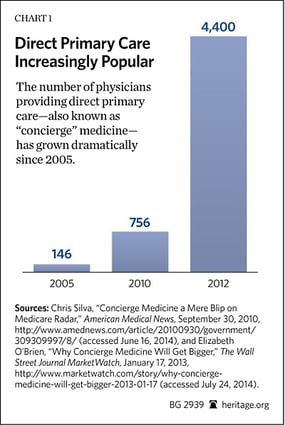 "Insurance-based primary care has grown increasingly complex, inefficient, and restrictive, driving frustrated physicians and patients to seek alternatives. Direct primary care is a rapidly growing form of health care that not only alleviates such frustrations, but also goes above and beyond to offer increased access and improved care at an affordable cost." - Dr. David Perkins
"Insurance-based primary care has grown increasingly complex, inefficient, and restrictive, driving frustrated physicians and patients to seek alternatives. Direct primary care is a rapidly growing form of health care that not only alleviates such frustrations, but also goes above and beyond to offer increased access and improved care at an affordable cost." - Dr. David Perkins
The days of using your insurance to see your doctor are limited.
Physician interest in direct primary care is growing due to the complexity of managing a practice. Many physicians say keeping up with insurance paperwork, software, electronic health records, and other initiatives tied to the Affordable Care Act leaves little time to actually practice medicine.
Doctors have to pay exorbitant amounts to pay for expenses that have nothing to do with the quality of medical care that the patients receive but have everything to do with the burdens of insurance.
Before doctors even open the doors of a new clinic that accepts insurance, they’ve had to hire a number of people just to manage the clinic’s relationship with insurance companies. Part of the clinic’s overhead expenses are these "insurance employees" that must be paid even when no patients come in. These employees are hired to call the insurance company to obtain prior authorization for suggested procedures. And then software has to be purchased to prepare the insurance bill that has to be in a very specific format. Even worse, more people have to be hired to call the insurance company to deal with insurance issues. As you can see, the overhead expenses these doctors have to pay is becoming very burdensome.
Related article: Is Direct Primary Care Right For You
If your doctor has four 15 minute visits per hour, he is paid anywhere from $250 to $370 per hour when you include the payment from the insurance company and the collected co-pay. Some of these doctors complain about an hourly overhead of $700. When your expenses are greater than your revenue the math doesn’t work, but this is the current state of primary care in the U.S.
What does your insurance company pay for your visit? For a typical follow-up visit, your insurance company pays anywhere from $50 to $80 to the doctor’s office. Also add your $20 co-pay to this amount. These visits are supposed to take 15 minutes face-to-face with the patient, which doesn't happen very often. To make matters worse, there have been numerous complaints about doctor's visists being too rushed and patients not getting their questions answered.
It's no surprise that more and more primary care doctors are switching to the direct primary
care model.

Direct primary care reduces the costs of care to the point where the average American can once again afford to see a physician on a regular basis. Insurance isn’t necessary within this relationship because the care is affordable. In reality, keeping insurance out is what makes this relationship functional and affordable. Insurance is for unpredictable events that would be financially catastrophic.
Direct primary care is the catalyst that is necessary to change the direction of health care in the U.S. It would likely even lead to better outcomes by allowing family physicians the actual amount of time that is necessary to help patients make substantial changes to their lives and overall health.
Is direct primary care right for you?

